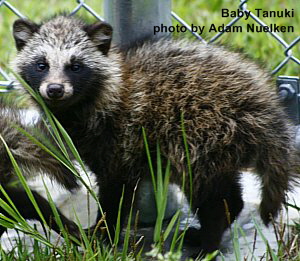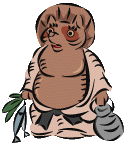|
|
|
|
MORE ABOUT THE TANUKI
Return to the main TANUKI page
Stories about Tanuki from The Japan Times

The Japan Times: July 27, 2001
(C) All rights reserved
- Japanese name: Tanuki
- Scientific name: Nyctereutes procyonoides viverrinus
- Description: Tanuki look a bit like fat foxes, with short legs and black and gray fur. They grow up to 60 cm. long and have distinctive stripes of black fur under their eyes, a bit like pandas.
- Where to find them: Standing at the door of many traditional restaurants in Japan. Statues of tanuki, holding a bottle of sake, welcome guests arriving to eat. Real tanuki are not so easy to find, but are quite abundant from Honshu to Kyushu. They live in lowlands, forests and mountain valleys (up to 2,000 meters in altitude) and sometimes come into gardens looking for food. Unfortunately for them, this can bring them into contact with dogs, from which they can catch dangerous diseases.
- Food: Almost anything. Tanuki are the classic omnivores, eating rodents, lizards, frogs, fruit, berries, insects and other invertebrates, including slugs and snails. They can even stomach poisonous toads, apparently producing huge amounts of saliva that dilutes the toad's poison.
- Special features: Tanuki don't usually carry bottles of sake, but the statues are correct about their biology in one important detail: testes size. Rather than being used as an impromptu drum, as Japanese folklore would have it, the scrotum is large because of high levels of competition among males for females. This means that they copulate very frequently -- and need large testes. Also, according to folklore, tanuki can change shape at will. Despite their playful nature, tanuki are wild animals and should never be kept chained up like in the photo above.
- The actual article can be viewed in The Japan Times’ archives at: www.japantimes.co.jp/cgi-bin/getarticle.pl5?fe20010727a1.htm
 BELOW STORY BELOW STORY
Tanuki, you old toad-eatin' rascal
story by Mark Brazil
for the Japan Times, July 29, 1998
The tanuki is found throughout Japan. In ceramic form it is even more widespread, perhaps even more numerous than the wild creature itself. This rather stout, short-legged creature with its short, bushy tail is an atypical member of the dog family.
The tanuki’s English name is raccoon dog, though if you search for that term on the Internet you may be surprised, as I was, to find that lots of Americans call a dog used for hunting raccoons a raccoon dog! That old chestnut of mistranslations, tanuki as badger, is as well represented on the Internet as it is elsewhere.
The Japanese name for the badger, an entirely different animal, is ana-guma. Not only that, some Web pages about tanuki actually feature pictures of raccoons.
The tanuki is the subject of innumerable amusing and intriguing myths and folk tales, and is often linked with the teakettle because of its pot-bellied appearance. Its image is that of a jolly, carousing and womanizing character. Like the kitsune (red fox), it is a master of shape-changing and disguise. The term tanuki-gao is often used to describe women with rounded facial features, in comparison with the more tapering kitsune-gao or "fox-face." In the past, it was hunted in Japan for its meat, its black-brown fur (used for making brushes) and its bones, which were reputed to have medicinal qualities.
The tanuki has also been introduced in several countries. Native to Japan, southeastern Siberia and Manchuria, tanuki were introduced to the western parts of the former U.S.S.R. for fur farming. Some escaped (or were released), and since the 1950s have spread westward into Scandinavia, and south even as far as France.
Whereas most members of the canid (dog) family live in open areas, tanuki occur in heavily wooded areas, often close to water. They are also more omnivorous than most other canids, and this is reflected in their teeth, which are relatively small. Their molars are enlarged, enabling them to tackle plenty of plant food, whereas their bone-shearing carnassial teeth are rather small.
As its teeth attest, the tanuki has a diverse diet, strongly dependent on the season and the region. It relishes invertebrates, small animals (frogs, lizards, rodents and ground-dwelling or ground-nesting birds) and (particularly in autumn) seeds and berries. Where they live by the sea, tanuki will also scavenge along the tide line in search of crabs and other marine life that washes up. They are most active soon after sunset throughout the evening, and then again in the early hours of the morning, during which time they may wander for 10 to 20 km in search of food.
Amazingly, raccoon dogs are one of’ the few animals able to eat toads. Apparently they produce such copious saliva that they are able to dilute the toads’ toxic skin secretion.
As tanuki have moved into suburban and even urban areas in Japan during the 1980s and 1990s, they have taken to feeding at rubbish dumps and are even fed by local people in their gardens. I was initiated into LOBATAWA, the Loyal Order of Backyard Tanuki Watchers, in a Kamakura garden in the early 1980s, where readers of this column had tamed their local tanuki with offerings of food. Residents are not kept awake at night by tanuki, for unlike other members of the dog family, they do not bark.
The tanuki is an unusual member of the dog family in many ways, not just in being barkless and having such an omnivorous diet, but also because it almost hibernates. It doesn’t actually sleep through the winter, but it does put on weight in autumn and then retreat into its burrow, from November until about April. It may emerge at times to feed, and in the warmer parts of their range, may hardly sleep at all.
Tanuki mate and rear their young in the spring, like most temperate mammals, so in late summer the young tanuki are learning their way around their home forest in preparation for the coming autumn and their first winter.
In some respects the tanuki has fared well during the last two decades. Winters during the 1980s were mild with rather brief periods of snow cover, hunting declined and perhaps as a result tanuki were able to extend their range into suburban and even urban areas. Because highly nutritious human food is plentiful in suburban habitats, these may actually be capable of supporting more tanuki than natural habitats.
Luckily, not only for tanuki, but also for other species of wildlife here, the numbers of hunters in Japan declined during the 1980s too. In a period of 10 years the number of tanuki killed by hunters halved from a peak of about 75,000 in 1981 to about 33,000 in 1990, according to Environmental Agency figures.
Unfortunately, its increased population densities in urban areas have led to new problems. At unnaturally high population densities, diseases are able to spread more readily than when their hosts occur at low densities, and it is disease that is now hitting the tanuki hard.
Recent research at Osaka City University indicates that many tanuki have become afflicted with sarcoptic mange, an uncomfortable condition caused by a parasitic mite. Infected tanuki suffer from skin deterioration and progressive hair loss leaving them partially, or even entirely, bald. In this state their likelihood of suffering and dying from hypothermia is greatly increased, and since about 1990, many have been found dead during winter.
Mange has been reported in a number of wild canids, most notably the red fox and the coyote, and since 1981 among Japanese raccoon dogs too. It appears that mange has been able to spread out from suburban areas with high tanuki densities into wilder areas too, leading to serious declines particularly in the Kanagawa and Miyagi prefecture populations. During the late 1980s and early 1990s, mange spread rapidly and the numbers of animals suffering increased greatly, especially in the relatively milder Pacific coastal prefectures.
Perhaps as the tanuki population falls it will become more difficult for the mange mite to spread. Let’s hope so. A bald tanuki is not a pretty sight.
The Japan Times - July 29, 1998
Return to the main TANUKI page
|
|